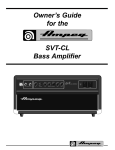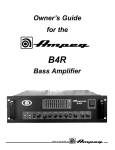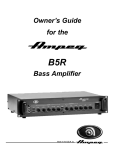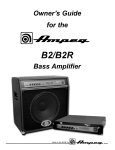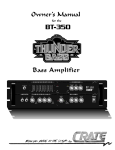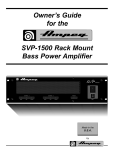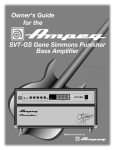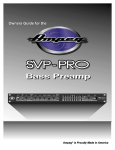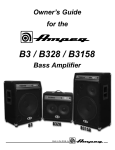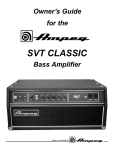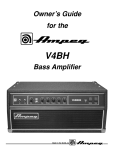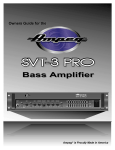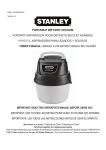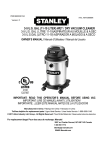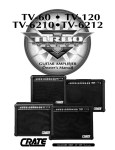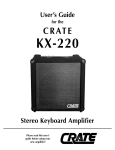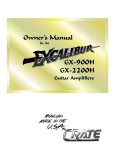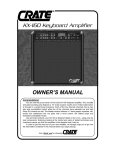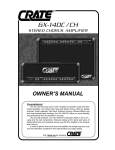Download Ampeg SVT-150H User's Manual
Transcript
Owner’s Guide for the SVT-150H Bass Amplifier Made in the U.S.A. by SVT-150H TABLE OF CONTENTS Introduction . . . . . . . . . . . . . . . . . . . . . . . . . . . . . .2 Features . . . . . . . . . . . . . . . . . . . . . . . . . . . . . . . .2 Important Safeguards and Precautions . . . . . . . . . .2 The Front Panel Controls and Their Use . . . . . . .3,4 The Rear Panel . . . . . . . . . . . . . . . . . . . . . . . . . .4,5 Some Suggested Settings . . . . . . . . . . . . . . . . . . .6 Troubleshooting . . . . . . . . . . . . . . . . . . . . . . . . . . .7 System Block Diagram . . . . . . . . . . . . . . . . . . . . . .7 Technical Specifications . . . . . . . . . . . . .back cover An Introduction to your new Ampeg SVT-150H Bass Amplifier Features In the world of high performance bass amps, Ampeg amplifiers stand alone. In true Ampeg tradition, your new SVT-150H offers you more power, performance and flexibility than any other bass amplifier in its class. Here are just some of the outstanding features of your new amplifier - features which set it apart from the competition! First of all, thank you for making what could be one of the best choices you could ever make concerning your musical career - choosing one of the finest bass amplifiers available, an Ampeg SVT-150H. Your new bass amplifier offers you many outstanding features, such as 150 watts of pure bass energy, total tone control and rugged construction which make it a true performer’s bass amp. • 9-BAND GRAPHIC EQ: Use as a “second channel” for bass solos, or to shape your sound to your own exacting standards. • BALANCED LINE OUTPUT: XLR with independent level control switch to patch into house consoles, mixing boards, or external power amplifiers. • EFFECTS LOOP: For increased intensity and quieter operation of external effects. • DRIVE CONTROL: To add harmonic content for tube-like overdrive. Important Safeguards and Precautions All Ampeg products are designed for continuous safe operation, as long as common sense is used and steps are taken to help avoid certain problems. Abiding by the following rules can help prevent damage to your amplifier, yourself and others. • The amplifier is equipped with a three-pronged AC power cord. To reduce the risk of electrical shock, NEVER remove or otherwise attempt to defeat the ground pin of the power cord. • Connect the amplifier ONLY to a properly grounded AC outlet of the proper voltage for your amp. • Avoid sudden temperature extremes, rain and moisture. Also, avoid sudden and intense impact. (If the unit has been subjected to any of the preceeding abuses, have it looked at by an authorized service center.) • NEVER set the amplifier on a support that might give out under its weight. • Always keep the total speaker impedance at or above the rated load. • Unplug the amplifier before cleaning it. NEVER spray liquid cleaners onto the amplifier. Wipe it with a slightly dampened, lint-free cloth to remove dirt and film. • Don’t use the amplifier if it has sustained damage to the chassis, controls, or power cord. Refer the unit to an authorized service center for inspection. • Amplifiers capable of producing high volume levels are also capable of inflicting permanent hearing loss or damage, if the exposure to such levels is prolonged. Such damage is progressive and irreversible! CAUTION ATTENTION VORSICHT RISK OF ELECTRIC SHOCK DO NOT OPEN RISQUE D'ELECTROCUTION NE PAS OUVRIR ELEKTRISCHE SCHLAGGEFAHR NICHT OFFENEN CAUTION: TO REDUCE THE RISK OF ELECTRIC SHOCK, DO NOT REMOVE COVER. NO USER-SERVICEABLE PARTS INSIDE. REFER SERVICING TO QUALIFIED SERVICE PERSONNEL. ATTENTION: POUR REDUIRE D'ELECTROCUTION NE PAS ENLEVER LE COUVERCLE. AUCUNE PIECE INTERNE N'EST REPRABLE PAR L'UTILISATEUR. POUR TOUTE REPARATION, S'ADRESSER A UN TECHNICIEN QUALIFIE. VORSICHT: ZUR MINIMIERUNG ELEKTRISCHER SCHLAGGEFAHR NICHT DEN DECKEL ABENHMEN. INTERNE TEILE KONNEN NICHT VOM BENUTZER GEWARTET WERDEN. DIE WARTUNG IS QUALIFIZIERTEM WARTUNGSPERSONAL ZU UBERLASSEN. THIS EQUIPMENT HAS BEEN DESIGNED AND ENGINEERED TO PROVIDE SAFE AND RELIABLE OPERATION. IN ORDER TO PROLONG THE LIFE OF THE UNIT AND PREVENT ACCIDENTAL DAMAGES OR INJURY, PLEASE FOLLOW THESE PRECAUTIONARY GUIDELINES: WARNING: TO REDUCE THE RISK OF ELECTRIC SHOCK, DO NOT OPEN CHASSIS; DO NOT DEFEAT OR REMOVE THE GROUND PIN OF THE POWER CORD; CONNECT ONLY TO A PROPERLY GROUNDED AC POWER OUTLET. CAUTION: TO REDUCE THE RISK OF FIRE OR ELECTRIC SHOCK, DO NOT EXPOSE THIS EQUIPMENT TO RAIN OR MOISTURE. CAUTION: NO USER-SERVICEABLE PARTS INSIDE. REFER SERVICING TO QUALIFIED SERVICE PERSONNEL. CAUTION: OUR AMPLIFIERS ARE CAPABLE OF PRODUCING HIGH SOUND PRESSURE LEVELS. CONTINUED EXPOSURE TO HIGH SOUND PRESSURE LEVELS CAN CAUSE PERMANENT HEARING IMPAIRMENT OR LOSS. USER CAUTION IS ADVISED AND EAR PROTECTION IS RECOMMENDED IF UNIT IS OPERATED AT HIGH VOLUME. The chart below shows the U.S. Government Occupational Safety and Health Administration (OSHA) regulations which were in effect at the time of this publication for permissible noise exposure, per 29CRF1910, Table G-16. SOUND LEVEL dBA SLOW RESPONSE DURATION PER DAY IN HOURS SOUND LEVEL dBA SLOW RESPONSE DURATION PER DAY IN HOURS 90 92 95 97 100 8 6 4 3 2 102 105 110 115 1-1/2 1 1/2 1/4 or less According to OSHA, any exposure in excess of those listed above could result in some hearing loss. 2 EXPLANATION OF GRAPHICAL SYMBOLS: "DANGEROUS VOLTAGE" = "DANGER HAUTE TENSION" "GEFAHLICHE SPANNUNG" "IT IS NECESSARY FOR THE USER TO REFER TO THE INSTRUCTION MANUAL" = "REFERREZ-VOUS AU MANUAL D'UTILISATION" "UNBEDINGT IN DER BEDIENUNGSANLEITUNG NACHSCHLAGEN" SVT-150H The Front Panel Controls and Their Use 1 2 3 4 5 6 7 1. INPUT: Connect your bass guitar here using a shielded instrument cable. 2. -15dB PAD: If your bass has high-output pickups or active electronics you may notice the Peak LED (#3) flashes or stays on even at low settings of the Gain control (#4). To keep the signal clean, switch in the Pad. This will attenuate the input signal to the preamp allowing you to get the best signal to noise ratio for your bass. 8 9 10 11 clockwise, signal level is increased to drive the preamp harder (into distortion). The tone of the signal is also changed to provide a smoother overdrive. The tone controls may have to be readjusted to obtain the overall desired tone. The Gain control (#4) and -15dB Pad (#2) interact with the Drive control. For greater overdrive, the Pad switch should be out and the Drive control fully clockwise. Use the Gain control to set the amount of overdrive desired. The Peak LED (#3) will glow steadily when the amp is used in this manner. 3. PEAK LED: This LED lights whenever any preamp stage is near the point of being over- 6. BASS: This knob serves as the primary low driven. Adjust the Gain control (#4) until a frequency control. This allows for a range of strong signal from your bass causes this LED 8dB of cut or boost at 50Hz. to flicker. 7. ULTRA-MID: This is the primary midrange NOTE: If the LED stays on with the Gain at a control. Rotate the control to the left of center low setting, use the 15dB Pad (#2) to attenu- for a “contoured” sound (more distant, less ate the input signal and readjust the Gain. midrange output) or to the right of center for a 4. GAIN: This serves as the input level control sound that really cuts through. 12 13 14 10. GRAPHIC EQ: These slide controls allow you to adjust the output of the frequencies shown beside each control. The center position of each control is flat (no boost or cut). These controls only affect the sound when the EQ is turned on. 11. MASTER: Set the overall output level of the amplifier with this control. The Effects Loop and Balanced Out (#18, 19, 22) are not affected by the Master control. Pulling the Master control turns on the Graphic EQ (#10). When the footswitch is used, the front panel switch is bypassed. 12. LIMIT LED: This LED indicator will flash on any time the internal limit circuit is called upon to keep amplifier’s output signal clean. This indicates that the amplifier is nearing full output and the limiter is keeping it from clipping the output signal. 13. POWER ON LED: This LED indicator for the amplifier. For the best signal-to-noise 8. TREBLE: This knob serves as the primary lights when the POWER switch (#14) is ratio set this control so the Peak LED (#3) high frequency control. This allows for a range turned on. flashes when you strike a string fairly hard. of 17dB boost or 22dB cut at 5kHz. 14. POWER SWITCH: This heavy-duty rock5. DRIVE: This control is used to overdrive the 9. EQ ON LED: This LED indicator lights er switch applies AC power to the amplifier: preamp in order to get various harmonic when you engage the EQ by the front panel the amp is ON in the up position, OFF in the enhancement or distortion sounds. In the fully Master control (#11) or the footswitch (#23, down position. counterclockwise position the preamp is in the rear panel). cleanest condition. As the control is rotated 1. ENTRADA: Conecte aquí su guitarra de bajos usando un cable blindado para instrumentos. NOTA: Si el LED permanece iluminado aún con la Ganancia en una posición baja, utilice la Terminal de -15 dB (#2) para atenuar la señal de entrada y 2. TERMINAL DE -15 dB: Si su bajo tiene capta- reajuste la Ganancia. dores de alta salida ó circuitos electrónicos activos, usted tal vez notará que el díodo (LED) de Picos 4. GANANCIA: Esto sirve como el control de (#3) parpadea ó permanece iluminado aún en posi- nivel de entrada para el amplificador. Para lograr la ciones bajas del control de Ganancia (#4). Conecte mejor relación de señal-a-ruido fije este control para esta Terminal para conservar limpia la señal. Esto que el LED de Picos (#3) parpadee cuando usted atenuará la señal de entrada hacia el preamplifi- pulse con fuerza alguna cuerda. cador, lo que le permitirá obtener la mejor relación 5. IMPULSO: Este control se usa para sobreimde señal-a-ruido para su bajo. pulsar el preamplificador a fin de conseguir varios 3. DIODO (LED) DE PICOS: Este LED se ilumi- realces armónicos ó sonidos de distorsión. En la nará cuando cualquier etapa de preamplificación se posición totalmente contraria a las manecillas del encuentre cerca del punto de sobreimpulso. Ajuste reloj, el preamplificador se encontrará en la posición el control de Ganancia (#4) hasta que una señal más “limpia”. Conforme el control se gire a favor de fuerte de su bajo cause un parpadeo de este LED. las mane-cillas del reloj, el nivel de la señal se incrementará para impulsar el preamplificador con mayor fuerza (hacia la distorsión). El tono de la señal también cambia para proveer un sobreimpulso más suave. Tal vez tengan que ajustarse los controles de tono para obtener el tono general deseado. El control de Ganancia (#4) y la Terminal de -15 dB (#2) interaccionan con el control de Impulso. Para un sobreimpulso mayor, el interruptor de la Terminal debe estar apagado y el control de Impulso totalmente a favor de las manecillas del reloj. Use el control de Ganancia para fijar la cantidad deseada de sobreimpulso. El díodo LED de Picos (#3) se iluminará en forma constante cuando el amplificadora se utilice de esta manera. 6. BAJOS: Esta perilla sirve como el control primordial para las frecuencias bajas. Esto permite un rango de 8dB de recorte ó de refuerzo a 50Hz. 3 SVT-150H The Front Panel Controls and Their Use 7. ULTRA-MEDIANOS: Este es el control primordial para el rango de las frecuencias medianas. Gire el control del centro hacia la izquierda para lograr un sonido de contorno (más distante, menor salida en el rango mediano) ó del centro hacia la derecha para obtener un sonido realmente penetrante. 10. EQ GRAFICO: Estos controles deslizantes (cursores) le permiten ajustar la salida de las frecuencias que se muestran junto a cada control. La posición central de cada control es plana (sin refuerzo ni recorte). Estos controles sólo afectan el sonido cuando el EQ esé prendido. 8. AGUDOS: Esta perilla sirve como el control primordial para las frecuencias altas. Esto permite un rango de 17 dB de refuerzo ó 22dB de recorte a 5kHz. 11. MAESTRO: Fije mediante este control el nivel general de salida del amplificador. El Circuito de Efectos y la Salida Equilibrada (#18, 19, 22) no se verán afectadas por el control Maestro. Jalando el control Maestro se prende el EQ Gráfico (#10). Cuando se utiliza el interruptor de pie, se pasa por alto el interruptor del panel delantero. 9. EQ EN LED: Este LED indicador se ilumina cuando usted activa el EQ mediante el control Maestro (#11) del panel delantero ó el interruptor de pie (#23) del panel posterior. 12. DIODO LED DE LIMITE: Este LED indicador parpadeará cada vez que se requiera el circuito limitador interno para conservar limpia la señal de salida del amplificador. Esto indica que el amplificador está aproximándose a su salida máxima y que el limitador está impidiendo el aplanamiento (“clipping”) de la señal de salida. 13. DIODO LED DE POTENCIA ENCENDIDA: Este LED indicador se ilumina cuando se prende el interruptor de POTENCIA (#14). 14. INTERRUPTOR DE POTENCIA: Este interruptor de servicio pesado tipo vaivén aplica la energía de CA al amplificador: el amplificador se PRENDE en la posición hacia arriba, y se APAGA en la posición hacia abajo The Rear Panel Made in the U.S.A. by SLM ELECTRONICS 1400 Ferguson Avenue • St. Louis, MO 63133 15 16 17 15. FUSE: This protects the unit from damage due to overload conditions or power line surges. If the fuse blows, replace it only with the same size and type. 18. EFFECTS RETURN: To use an external effects device or other signal processor, connect the OUTPUT of the device to this jack using a shielded cable. This feeds the processed signal into the amplifier’s master 16. AC LINE IN: Firmly plug the supplied section. AC power cord into this socket, pushing it in until it is fully seated. Plug the male end of 19. EFFECTS SEND: Connect the output the cord into a grounded AC outlet. DO from this jack to the INPUT of an external NOT DEFEAT THE GROUND PRONG OF effects device using a shielded cable. This THE AC PLUG! sends a post-EQ signal to your effects. Since plugging a cable in here does not 17. SPEAKER OUTPUT(S): The SVT- break the through connection to the power 150H has two 1/4” speaker output jacks amp, this can be used as another line out. which you will use to connect to your bass cabinet(s). Use speaker cables with 1/4” 20. PRE/POST SWITCH: You can select plugs to connect the SPEAKER jack(s) to either pre or post-EQ for the signal at the the cabinet(s). Observe the 4 ohm minimum Balanced Out jack (#22) with this switch. impedance rating. Please see the note With the switch in the OUT position, the sigconcerning the speaker output jacks on nal at the jacks will be pre-EQ. This is a the facing page. direct output which is not affected by any EQ or boost settings. With the switch in, the The following chart shows the total signal is post-EQ and is controlled and impedance load when connecting speaker modified by the tone controls, Graphic EQ cabinets in parallel: and Effects Loop. 4 Cabinet Impedance # of Cabs Total Impedance 8Ω 16Ω 16Ω 2 2 4 4Ω 8Ω 4Ω 18 19 20 21 22 23 21. -20dB SWITCH: This switch adjusts the output level at the Balanced Out jack (#22). The switch works independently from the front panel Master control. Pushing the switch in activates the -20dB pad, allowing patching into microphone inputs on a mixer without overdriving them. 22. BALANCED OUT: This XLR-type connection supplies a balanced preamp output signal for connecting to a house mixing board, recording console or external amplifiers with balanced inputs. The signal can be set to pre or post-EQ by the Pre/Post switch (#20). The level can be adjusted for either mic or line type inputs using the -20dB switch (#21). 23. FOOTSWITCH: This jack accepts the 1/4” plug from a 1-button footswitch, allowing remote control of the Graphic EQ on/off function. When a footswitch is used, the front panel Master Pull EQ On switch (#11) is bypassed. SVT-150H The Rear Panel 22. SALIDA EQUILIBRADA: Esta conexión tipo XLR proporciona una señal de salida equilibrada de preamplificación para conectarse a un tablero mezclador local, una consola grabadora ó amplificadores externos con entradas equilibradas. La señal se puede 16. ENTRADA DE LA LINEA DE CA: establecer como pre ó post-EQ mediante el Conecte firmemente a este receptáculo el 19. ENVIO DE EFECTOS: Conecte la salida interruptor Pre / Post (#20). El nivel se puede cable suministrado de corriente de CA, oprim- de este “jack” a la ENTRADA de un dispositi- ajustar para entradas de tipos ya sean de iéndolo hasta que quede totalmente asenta- vo de efectos externo usando un cable blinda- micrófono ó de línea utilizando el interruptor do. Enchufe el extremo macho del cordón a do. Esto envía una señal post-EQ a sus efec- de -20dB (#21). una salida aterrizada de CA. ¡NO PASE POR tos. Siendo que la conexión de un cable en ALTO EL BORNE DE TIERRA DE LA CLAV- este lugar no rompe la conexión directa al 23. INTERRUPTOR DE PIE: Este “jack” IJA DE CA! amplificador de potencia, esto se puede uti- acepta la clavija de 1/4” de un interruptor de pie de un solo botón, lo que permite un conlizar como otra linea hacia afuera. 17. SALIDA(S) DE LA(S) BOCINA(S): El trol remoto de la función de prender / apagar SVT-150H tiene dos “jacks” de salida para 20. INTERRUPTOR PRE/POST: Usted del EQ Gráfico. Cuando se utiliza un interrupbocinas que usted usará para conectarse a puede seleccionar por medio de este inter- tor de pie, se pasa por alto el interruptor su(s) gabinete(s) de bajos. Use cables para ruptor ya sea pre ó post-EQ para la señal en Maestro para Prender ó Jalar el EQ (#11). bocinas con clavijas de 1/4” para conectar el el “jack” de Salida Equilibrada (#22). Con el (los) “jack(s)” de la(s) BOCINA(S) al (los) interruptor en la posición de FUERA, la señal gabinete(s). Observe la especificación de 4 en los “jacks” será pre-EQ. Esta es una salida directa no afectada por ningunas posiciones ohms de impedancia mínima. del EQ ó de refuerzo. Con el interruptor hacia La tabla a continuación muestra la carga adentro, la señal es post-EQ y se controla y de impedancia total cuando se conecten gabi- modifica mediante los controles de tono, el netes de bocinas en paralelo: EQ Gráfico y el Circuito de Efectos. 15. FUSIBLE: Esto protege a la unidad contra daños debidos a condiciones de sobrecarga ó sobretensiones transitorias en la línea de energía. Si el fusible se quema, repóngalo sólo con el mismo tipo y tamaño. Impedancia de cada Gabinete # de Gabinetes Impedancia Total 8 ohms 16 ohms 16 ohms 2 2 4 4 ohms 8 ohms 4 ohms 18. RETORNO DE EFECTOS: Para utilizar un dispositivo de efectos externo ú otro procesador de señales, conecte la SALIDA del dispositivo a este “jack” usando un cable blindado. Esto alimenta la señal procesada a la sección maestra del amplificador. 21. INTERRUPTOR DE -20dB: Este interruptor ajusta el nivel de salida en el “jack” de Salida Equilibrada (#22). El interruptor funciona independientemente del control Maestro del panel delantero. Al oprimirse el interruptor hacia adentro se activa la terminal de los -20dB, lo que permite conectarse a las entradas para micrófonos en un mezclador sin sobreimpulsarlos. NOTE: In some areas 1/4” speaker jacks are not acceptable for use on amplifiers capable of high output power levels. For this reason the Speaker jacks on your amplifier may resemble the illustration to the right. Connect the amplifier to your speaker(s) using cables rated for very high output power, terminated with the appropriate connectors. 5 SVT-150H Some Suggested Settings ROCK: JAZZ: COUNTRY: FUNK “POPPING:” 6 The setting of the Gain control depends on your particular instrument. The Master should be set to produce the appropriate output volume level. The Graphic EQ can be used to tailor the amplifier to your speaker cabinets, to compensate for room acoustics and to “fine tune” your sound. SVT-150H Troubleshooting In the unlikely event that you SVT-150H should stop working properly (or just stop working), take a few minutes to troubleshoot it before you call for service. You can save yourself a lot of time and sometimes money by doing it yourself, and often the cure for the problem is something quite simple. NO SOUND POOR SOUND LEDs LIGHT LEDs DON'T LIGHT Check bass, cables Check amp controls, check for signal from bass Check AC outlet POOR SOUND OUTLET OK NO OUTLET Check speaker(s) NO SOUND SOUND OK SOUND OK Check power cord, fuse, power switch Listen for hum NO HUM HUM Check speaker Unplug bass, touch tip of cable Check house fusebox or circuit breaker SPEAKER(S) OK, POOR SOUND OK Speaker OK Replace speaker(s) POOR SOUND NO CHANGE LOUD HUM Replace cable Check inst. pickup NO CHANGE SOUND OK SOUND OK SPEAKER(S) DEFECTIVE SEE BELOW SOUND OK SEE BELOW If the problem isn’t covered above, or if the steps led you here, then contact your Ampeg dealer for service information. Also, you should refer your amp for servicing if it gets dropped, has liquid spilled into it, or sustains damage to its power cord (see page 2). System Block Diagram PEAK LED TONES INPUT -15dB GAIN DRIVE 9 BAND EQ FOOT SWITCH EQ ON BASS TREBLE ULTRA MID 1+ 1– LIMIT LED SPEAKON® JACK MASTER POWER AMP EFFECTS SEND EFFECTS RETURN POST SPEAKER OUTS 2 PRE -20dB 3 BALANCED OUT 7 SVT-150H Technical Specifications OUTPUT POWER RATING POWER REQUIREMENTS 150 Watts RMS, 4Ω load, 115VAC Domestic: Export: 115VAC, 60Hz, 140VA 100/115VAC, 50/60Hz, 140VA 230VAC 50,60Hz, 140VA Bass: Ultra-Mid: Treble: ±8dB @ 50Hz +5, -17dB @500HZ +17, -22dB @ 5KHZ TONE CONTROL RANGE GRAPHIC EQ RANGE 40Hz 80Hz 150Hz 300Hz 600Hz 900Hz 2kHz 5kHz 9kHz GAIN SIGNAL TO NOISE RATIO SIZE (W x H x D) AND WEIGHT ±11dB ±8dB ±8dB ±8dB ±8dB ±8dB ±8dB ±9dB ±12dB 66dB typical, tones @ center 75dB typical 19”x9.5”x12.5”, 30 lbs Ampeg reserves the right to change specifications without notice. Ampeg is proudly Made in America. ©1997 SLM Electronics, 1400 Ferguson Avenue, St. Louis, MO 63133 U.S.A. P/N 47-588-52 . 01/97








